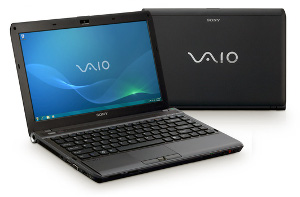
Model: Sony
Vaio VPC S12 C5E
Processor: Intel Core i7 quad, 2.6 GHz
Graphics: Nvidia Geforce 310M, 512 MB, 1366x768 on 13"
Network (wired): Atheros AR8131 (1 Gbit)
Network (wireless): Intel WiFi Link 6000 (600 Mbit, N)
Bluetooth: yes
Webcam: yes
Modem: no
Media: DVD writer
BIOS: F2

In 2010-07, I bought my Sony Vaio VPC S12 C5E, a customized version with a Core i7 processor and other goodies. Ubuntu 10.4 Lucid Lynx had come out, a long-time service (LTS) release. As with the predecessor, the Sony Vaio VGN SZ61 MN/B, I am moderately satisfied, having the following minor issues:
Overall, I think that the Linux experience is not very smooth out-of-the-box. The fan noise is so low it does not bother me (at lowest down-clocking), but the implications for power saving do. Currently, I run Ubuntu 10.4 (Lucid Lynx) under a 2.6.32 kernel.
Throughout this guide, I assume that you do sudo su to
become root wherever necessary (which is most of it).
The first challenge presents itself at bootup. Using F2,
go to the BIOS and make USB bootable. Then, the Ubuntu boot menu
pops up. Specify kernel option nomodeset (and
optionally remove quiet and splash), otherwise
you will get a blank screen and see nothing. Seriously. In the Ubuntu
forums, this is a known problem.
Once Ubuntu is installed, you need to do the same to grub. Since
grub2 has replaced grub, the old /boot/grub/menu.lst
does not work anymore. Instead, change /etc/default/grub
and the files in /etc/grub/, as recommended by the Ubuntu community:
nano -w /etc/default/grub
GRUB_DEFAULT=1
GRUB_CMDLINE_LINUX_DEFAULT="nomodeset vga=792
i8042.nopnp"
GRUB_GFXMODE=1360x768
GRUB_DISABLE_LINUX_RECOVERY="true"
nano -w /etc/grub.d/09_windows
#!/bin/sh
exec tail -n +3 $0
menuentry "Windows 7" {
insmod ntfs
set root='(hd0,2)'
chainloader +1
}
update-grub2
The above adds a dedicated Windows 7 entry at first position,
uses almost the exact screen size (1366x768 is not supported, so I
take 1360x768) and adds nomodeset to the boot option.
The vga=792 setting is optional, and I will explain the
i8042.nopnp later.
To keep the fan running at lowest levels (at least when on
battery), the CPU frequency selector can help you. There is a
command line version, cpufreq-selector, and a Gnome
panel version, CPU Frequency Monitor. In the GUI:
Panel->Add to Panel->CPU Frequency Scaling Monitor
CPU Freq Monitor->Conservative
CPU Freq Monitor->1.2 Ghz
Or alternatively, on the command line:
cpufreq-selector -g Conservative
cpufreq-selector -f 1200
The conservative setting is mostly sufficient, and is my default. When on battery, sometimes I set it to 1.2 GHz manually for optimal power saving.
The Nvidia graphics is some effort to set up. In line with the Ubuntu
forums, you need to boot Windows, install SoftMCCS
and retrieve the EDID file for your monitor (no kidding). Save it
e.g. as sony_s12_edid.bin and copy it to /etc/X11.
Then, install Nvidia proprietary drivers and remove the installed Noveau ones. Some help on this is available in the Ubuntu community.
System->Administration->Restricted Drivers Manager
NVidia accelerated driver: yes
apt-get --purge remove xserver-xorg-video-nouveau
Then, create a baseline xorg.conf file. You may need to
switch to the console (e.g. Alt+F1) and to sudo su
there, then stop gdm to work without X (yes, /etc/init.d/gdm
stop does not exist anymore). Then, reference the EDID file
in it.
nvidia-xconfig
nano -w /etc/X11/xorg.conf
Section "Screen"
...
Option
"ConnectedMonitor" "DFP-0"
Option
"CustomEDID" "DFP-0:/etc/X11/sony_s12_edid.bin"
Option
"ModeValidation" "NoWidthAlignmentCheck,
NoDFPNativeResolutionCheck"
SubSection "Display"
Depth 24
Modes "nvidia-auto-select"
EndSubSection
EndSection
After that, do start gdm (or a reboot), and use Preferences->Screen
Resolution for 1366x768.
The touchpad does not run out of the box. Both the Ubuntu forums (de) and Frederik Questier have advice on this. Surprisingly, the answer is a kernel option.
nano -w /etc/default/grub
# alternatively, "acpi=off" also works, but
then shutdown is incomplete.
GRUB_CMDLINE_LINUX_DEFAULT="... i8042.nopnp"
System->Preferences->Mouse
Touchpad
Enable mouse clicks with
touchpad == false
This is the i8042.nopnp option, which disables plug and
play for the touchpad. Also, optionally you can deactivate the
"one touch means click" behaviour on the preferences.
Sound output with headphones works out of the box, with internal speakers not. I have not found a conclusive solution yet. Some forums recommend alsa-generic-backports-karmic, others self-compiled alsa drivers. In any case, try the following diagnostics:
cat /proc/asound/card0/codec#0 |grep Codec
This will tell you that the S12 has a "Realtek ID 275" card.
Since headphones are my default mode anyway, I will not delve too much into this, and hope that a future alsa update will fix this. Update: Indeed an update in 2011 repaired this.
The motion eye camera works out of the box, I had no expected this.
apt-get install xawtv
xawtv
Skype also works.
The bluetooth adapter is not recognized out of the box, as System->Preferences->Bluetooth
and hcitool -dev tell me. I will wait on this one.
The following open ends remain:
I am curious whether the Nvidia/text console problem will ever vanish.
The Sony Vaio S12 C5E is challenging work to configure, but mostly I can live with it. Though the always running fan makes it less than ideal for power saving purposes, it is still a beautiful piece of hardware.
With that, I hope this article could help or inform you a little
bit. If you have any questions or comments, you can reach me via
email to kain at the above domain. Thanks for leaving a
part of your attention span here, and have a good day!
Last Update: 2010-09-19. This article is listed at TuxMobil.
EOF (Sep:2009)